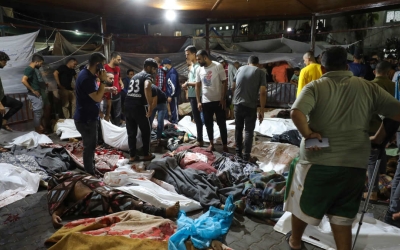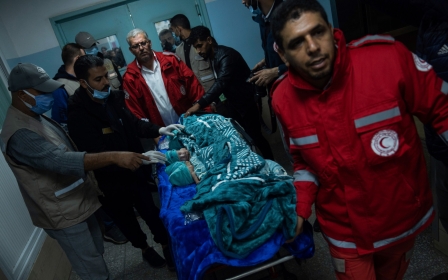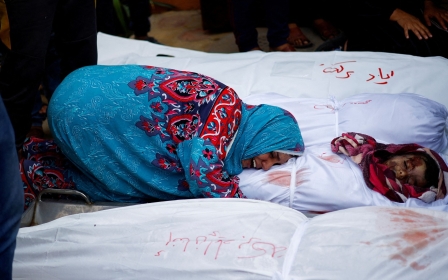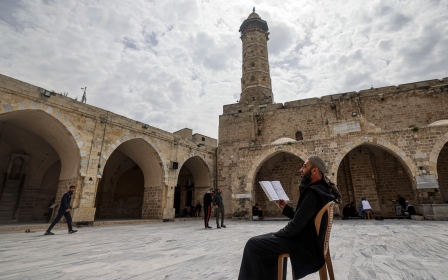Israel-Palestine war: Human Rights Watch calls for impartial investigation into al-Ahli hospital blast

Human Rights Watch has called for an investigation into the strike at al-Ahli hospital in Gaza City, asking Israel and Hamas to come forward with evidence about the strike.
In a report published on Sunday, Human Rights Watch said evidence suggests that the bombing of al-Ahli hospital in Gaza City was caused by an apparent rocket-propelled munition like those used by Palestinian fighters.
Human Rights Watch said it was “highly unlikely” the deadly strike was caused by the type of large, air-dropped bombs Israel has deployed in Gaza, but said that a full investigation will be needed to determine who launched the rocket.
"The decades-long failure of both Israeli and Palestinian authorities to credibly and impartially investigate alleged violations of international humanitarian law underscores the need for an independent investigation into the incident, which could be conducted by the United Nations Commission of Inquiry, and for all parties to fully cooperate," the report said.
The Human Rights Watch report was based on photos and videos taken before and after the explosion, in addition to interviews with witnesses and experts.
“The sound preceding the explosion, the fireball that accompanied it, the size of the resulting crater, the type of splatter adjoining it, and the type and pattern of fragmentation visible around the crater are all consistent with the impact of a rocket,” the report said.
Israel has mainly deployed air-dropped bombs and artillery shells in Gaza, while Palestinian fighters have used locally produced rockets and others smuggled into Gaza via Sudan and Egypt.
The report said that the limited blast damage at the crater is inconsistent with high-explosive detonations such as those caused by large air-dropped bombs or artillery.
The Human Rights Watch report was slammed by some Palestinian NGOs.
They said it failed to rule out Israel using a new type of munition that would cause less impact at the blast site. They also labelled the report as “premature” because it was based on video and photographic evidence, but not an on-site inspection of the hospital.
Human Rights Watch acknowledged that it had conducted a “remote analysis”, adding that its inability to visit the site had prevented “conclusive identification” of the munition used.
'Munition remnants'
“Authorities in Gaza and Israel should release the evidence of munition remnants and other information they have regarding the al-Ahli hospital explosion to allow for a full investigation,” HRW crisis and conflict director Ida Sawyer said.
Palestinian officials in Gaza are in possession of munition remnants that would help make a conclusive determination of the type of munition used at the blast, Human Rights Watch said, but they have not released those fragments publicly despite vowing to do so.
Video footage of the blast has been debated for more than a month.
In October, the New York Times reported that a video widely shared by the Israeli military as evidence that an errant Palestinian rocket caused the blast, actually showed a missile that had been launched from Israel exploding at least 3.2 kilometres away from the hospital.
But the Human Rights Watch report cited other video footage including one of a barrage of Palestinian rockets launched about five kilometers southwest of al-Ahli hospital. It also relied on verified and geolocated video filmed 160 metres from the hospital in the instant before and during the main explosion.
"The sound characteristic of a munition propelled by a motor, such as a rocket or a missile, can be heard. This sound is not consistent with artillery shells or air-dropped bombs,” Human Rights Watch said.
Human Rights Watch has previously reported on rockets fired by Palestinian fighters that have accidentally struck areas in Gaza.
Rockets used by Palestinian fighters in Gaza have only “rudimentary guidance systems and are prone to misfire, making them extremely inaccurate and thus inherently indiscriminate when directed toward areas with civilians,” the report added.
More than 15,000 Palestinians, more than half of them being women and children, have been killed by Israel’s military operations in Gaza, which were launched after Hamas’s surprise 7 October attack on Israel killed around 1,200 Israelis, mainly civilians.
Battle for public opinion
The 17 October explosion at the hospital has not only become one of the war’s most defining moments, but underscores the raw divisions over the conflict and the battle for public opinion between Hamas and Israel.
Palestinian officials and leaders across the Middle East, including Arab rulers close to the West, immediately blamed Israel for the blast, whereas Israel said a malfunctioning rocket launched by Islamic Jihad was responsible. The group denied the allegation.
The strike came just before US President Joe Biden’s wartime visit to Israel. Pressed on who caused the explosion during his trip to Tel Aviv, Biden said it appeared “the other team”, not Israel, was responsible for the strike.
The opposing sides have also disputed the death toll.
Palestinian health officials initially said more than 500 people were killed by the strike, then lowered the death toll to 471. An unclassified US intelligence document put the death toll at 100 to 300 people.
The Human Rights Watch report carries weight because the organisation has been critical of Israel’s policies. Last month, it warned that Israel was using white phosphorous "unlawfully" in the Gaza Strip and Lebanon, citing the risk it poses to civilians.
Middle East Eye propose une couverture et une analyse indépendantes et incomparables du Moyen-Orient, de l’Afrique du Nord et d’autres régions du monde. Pour en savoir plus sur la reprise de ce contenu et les frais qui s’appliquent, veuillez remplir ce formulaire [en anglais]. Pour en savoir plus sur MEE, cliquez ici [en anglais].





